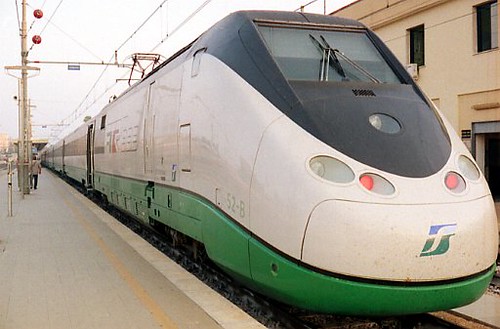
A high-speed train at the platform in Milan, Italy.You may have noticed TSP's last article was titled A Snapshot on Nuclear Energy. The over-arching concept of this blog was to intermix shorter articles that give a nice overview of a subject, with long-form legislative analysis, report summaries, opinions, etc. The article on nuclear energy was an example of the short-form articles, I deemed it a Snapshot for lack of a better term, but now I have a better term: Abstract. Why Abstract? An abstract in science is a short description of the following paper, it hits all the main points, and gives a nice overview of what the scientist is going to discuss in his or her research paper. Just the same, an abstract in The Science Politico is going to give a short overview of a topic of interest, hit all the main points, and then hopefully leave the reader with an ever so slightly increased awareness of the subject.
And now without further ramblings on blogging philosophy, an abstract on high-speed rail:
High Speed Rail
High Speed Rail (HSR) means different things in different countries. In the European Union, trains on upgraded track must travel at least 200 km/h (120mph), and trains on newly built track must travel at least 250 km/h (156mph) to be considered high speed. On Japan's Shinkansen lines, trains run at speeds of up to 260 km/h (162mph), and in China top speeds are around 350 km/h (220mph). The United States you ask? Well, maybe it is better if you did not.

The United States and High Speed Rail, One Main Question: Do We Have It?
The above posted graph seems to suggest the United States has 730 kilometers of High Speed Rail. This was news to me, since I could not readily think of any high speed lines in the United States. I thought about this a little bit, and then it hit me: The Acela. Yes, you read that correctly, the Acela blazing by at an average speed of 70mph, (top speeds though, to be fair, are a decent 150mph) is considered high speed rail. Now, having ridden the Acela from New York City to Providence, I was sort of bemused to find out that it was considered "High-speed." This is because the standard is different in the United States, slightly lower than that of Europe. The Federal Rail Road Administration divides HSR into three categories:
High-Speed Rail Express: Top speeds of 150mph
High-Speed Rail Regional: Top speeds of 110mph-150mph
Emerging High-Speed Rail: Top speeds of 90mph-110mph
Source
None of these criteria talk about average speed, so as long as the Acela can reach up to 150mph, which it does south of New York for a short strech, it is considered high-speed rail.
Turning back to the graph, it is fairly obvious the United States has nowhere near the amount of High Speed Rail lines that Europe, China, and Japan have. However, several projects are in the works to add to the U.S. HSR Infrastructure:
The Midwest, Florida, and California.
In the Midwest the plan is to connect Chicago with St. Louis, and then with Kansas City. In Florida, the proposed track would first go from Tampa to Orlando, and then later from Orlando to Miami. In California the idea is for the train to go from Los Angeles to San Francisco.
So in otherwords, the strategy for U.S. high-speed rail is to develop corridors. Which I think is the right approach, since the U.S. is far too large to have any sort of country-wide connectedness that Europe has. Also for HSR to dream of keeping the books out of the red, it needs to connect the high population areas with large potential for ridership: AKA corridors that see a lot of travel. In this case, the Acela has the right idea, with annual ridership of 3,000,000 a year along the busy corridor from Boston to Washington, DC.
As far as whether High Speed Rail will actually find ridership in a country addicted to cars, that is another post for another day, but the ridership levels on the Acela are encouraging, and when gas prices go up (when we're digging through tar sands to get at oil...), train ridership increases Amtrak has the data to show it. In short, developing infrastructure that is likely to prove popular both now, and in the future is not a bad idea, especially when the technology is proven, and the United States is embarrassingly behind the rest of the world.
...Plus what could High-Speed Rail Hurt?
Further Reading
Siemens Website for High Speed Rail
Time Article
No comments:
Post a Comment